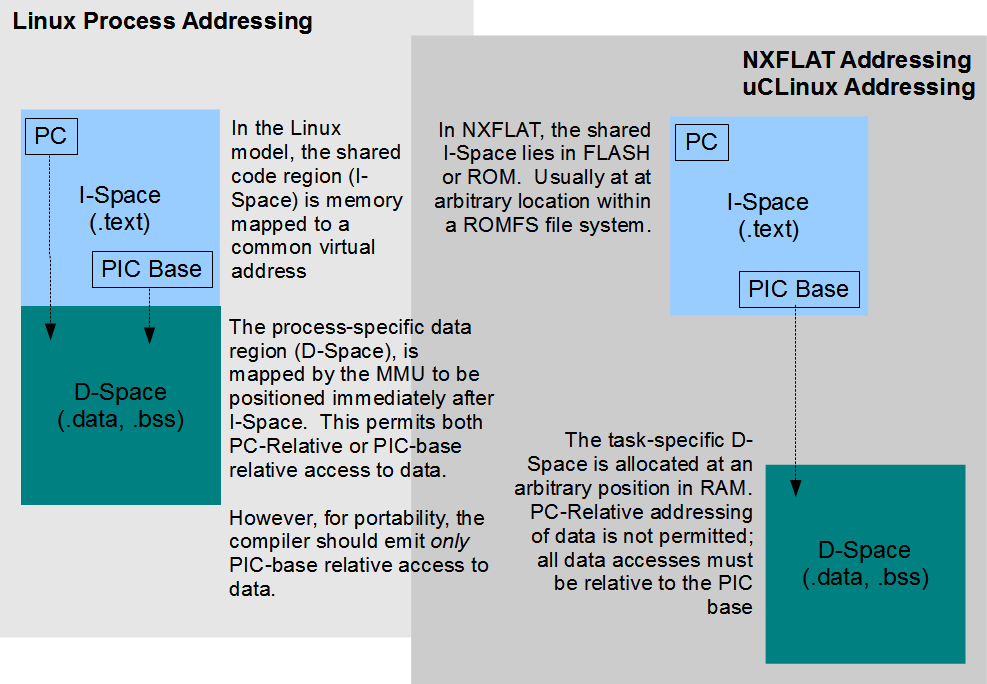NuttX FLAT Binary Format (NXFLAT)
Warning
Migrated from: https://cwiki.apache.org/confluence/pages/viewpage.action?pageId=139630111
Overview
NuttX supports a configurable binary loader . This binary loader supports loading and executing binary objects from the file system. The NuttX binary loader is capable of supporting multiple binary formats. One of of those binary formats is NXFLAT, the top of this Wiki page.
NXFLAT is a customized and simplified version of binary format implemented a few years ago called XFLAT. With the NXFLAT binary format you will be able to do the following:
Place separately linked programs in a file system, and
Execute those programs by dynamically linking them to the base NuttX code.
This allows you to extend the NuttX base code after it has been written into FLASH. One motivation for implementing NXFLAT is support clean CGI under an HTTPD server.
This feature is especially attractive when combined with the NuttX ROMFS support: ROMFS allows you to execute programs in place (XIP) in flash without copying anything other than the .data section to RAM. In fact, the initial NXFLAT release only worked on ROMFS. Later extensions also support execution NXFLAT binaries from an SRAM copy as well.
This NuttX feature includes:
A dynamic loader that is built into the NuttX core (See SVN).
Minor changes to RTOS to support position independent code, and
A linker to bind ELF binaries to produce the NXFLAT binary format (See SVN).
Toolchain Compatibility Problem
Description
NXFLAT flat requires a specific kind of position independence.
The ARM family of GCC toolchains has historically supported
this method of position independence: All code addresses are
accessed relative to the Program Counter (PC) and a special,
PIC register (usually r10) is used to access all data. To
load or store a data value, the contents of r10, the PIC
base, is added to a constant, position-independent offset
to produce the absolute address of the data.

The Global Offset Table (GOT) is a special data structure that
resides in D-Space. So PIC-base relative addressing may also
be specified as GOT-Relative addressing (or GOTOFF). The older
GCC 4.3.3 GCC compiler, for example, generates GOTOFF
relocations to the constant strings, like:
.L3:
.word .LC0(GOTOFF)
.word .LC1(GOTOFF)
.word .LC2(GOTOFF)
.word .LC3(GOTOFF)
.word .LC4(GOTOFF)
Where .LC0, .LC1, .LC2, .LC3, and .LC4 are the labels
corresponding to strings in the .rodata.str1.1 section. One
consequence of this is that .rodata must reside in D-Space
since it will addressed relative to the GOT (see the section
entitled “Read-Only Data in RAM” here).
The newer 4.6.3 GCC compiler, however, generated PC relative relocations to these same strings:
.L2:
.word .LC0-(.LPIC0+4)
.word .LC1-(.LPIC1+4)
.word .LC2-(.LPIC2+4)
.word .LC3-(.LPIC4+4)
.word .LC4-(.LPIC5+4)
These are PC-Relative relocations. This means that the string
data is address not by an offset relative to the PIC register
(r10) but to the program count (PC). This is good and bad. This
is good because it means that .rodata.str1.1 must now can now
reside in FLASH with .text and can be accessed using PC-relative
addressing. That can be accomplished by simply moving the .rodata
from the .data section to the .text section in the linker script.
The NXFLAT linker script is located at
nuttx/binfmt/libnxflat/gnu-nxflat-?.ld. NOTE: There are two
linker scripts located at nuttx/binfmt/libnxflat/:
binfmt/libnxflat/gnu-nxflat-gotoff.ld.Older versions of GCC (at least up to GCC 4.3.3), use GOT-relative addressing to access RO data. In that case, read-only data (.rodata) must reside in D-Space and this linker script should be used.binfmt/libnxflat/gnu-nxflat-pcrel.ld.Newer versions of GCC (at least as of GCC 4.6.3), use PC-relative addressing to access RO data. In that case, read-only data (.rodata) must reside in I-Space and this linker script should be used.
But this is very bad because a lot of NXFLAT is now broken. For it appears that not just constant strings, but that all data may now be referenced using PC-relative addressing to .bss and .data values. I do not yet know the extent of this problem or the direction that GCC is going but certainly version 4.6.3 cannot be used with NXFLAT.
The workaround for now is to use the older, 4.3.3 OABI compiler. In the long run, this might spell the end to NXFLAT.
Update: Restored GCC Support
This post was pointed out by Michael Jung:
MCU: STM32F4 (ARM Cortex M4)
Build environment: arm-none-eabi-gcc 4.8.4 20140725
My goal is to build an image that can be run from any properly-aligned
offset in internal flash (i.e., position-independent). I found the
following set of gcc flags that achieves this goal:
# Generate position independent code.
-fPIC
# Access bss via the GOT.
-mno-pic-data-is-text-relative
# GOT is not PC-relative; store GOT location in a register.
-msingle-pic-base
# Store GOT location in r9.
-mpic-register=r9
Reference: https://gcc.gnu.org/ml/gcc-help/2015-07/msg00027.html
Michael has verified that -mno-pic-data-is-text-relative is,
indeed, a solution to the above NXFLAT problem in newer
compilers. You simply need to modify the board Make.defs
file like:
ARCHPICFLAGS = -fpic -msingle-pic-base -mpic-register=r10
+ARCHPICFLAGS = -fpic -msingle-pic-base -mpic-register=r10 -mno-pic-data-is-text-relative
NOTE the minor difference from the post: NuttX uses r10 as
the PIC base register by default in all configurations.
See this thread for additional information.